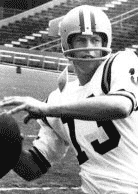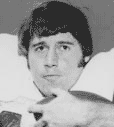Tiger Firsts: Victory, Home Victory, Winning Season
The school's first gridiron aggregation had played only one game in 1893, a 34-0 loss to Tulane in New Orleans. Before the next season, Dr. Charles Coates, who had organized the team, persuaded the school administration to hire a professional coach, A. P. Simmonds, an end on Yale's 1893 team. His $300 salary was covered by donations from the university's cadet corps and supporters. Simmons faced an uphill battle in several respects. Not only was his team inexperienced, but not everyone was convinced football was a good thing for LSU. The Baton Rouge Daily Advocate ran negative editorials in 1893 after the Tulane debacle and again in the fall of 1894.
Students are sent to college to be educated into refined and intellectual gentlemen, and not to choose between having their necks broken in a hurly burly scramble, or escaping that, to be turned out at the end of four years burly and accomplished bruisers.
[The writer didn't want to see] the spectacle of young men fracturing their shins, getting their jaws broken, their noses spread out all over their faces, and a half dozen ribs knocked clear through on the other side. ... Instead of being encouraged by our institutions of learning, [football] should be strictly prohibited.
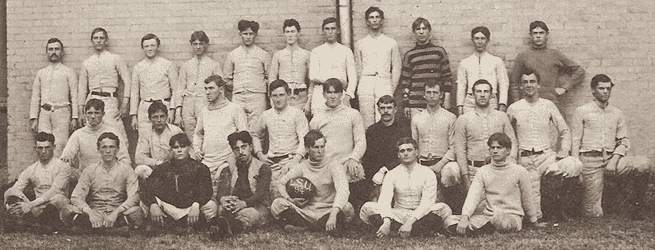 1894 LSU Football Team
Despite opposition, Simmonds whipped his 28-man squad into shape on the parade grounds south of the Pentagon Barracks on the campus in downtown Baton Rouge (near the current capital building). As the team boarded the steamboat Royal for the trip upriver to Natchez for the opening game against the Natchez Athletic Club, Simmonds expressed optimism to the cadets who gathered for the sendoff.
The team nearly didn't make it to the game. The Royal ran aground 20 miles below Natchez, and the steamer Natchez was dispatched to their rescue after seven hours. As a result, the game was postponed one day. LSU, showing no ill effects from the trip, won easily, 36-0. The Daily Advocate writer reported that "while the game was a strong one there was an entire absence of any display of brutality, and consequently there were no casualties ..."
Exultation was short-lived. Three days later, Ole Miss defeated the Tigers 26-6 in Baton Rouge. The Rebels so dominated the action that Coach Simmonds asked for and received permission to line up in the backfield late in the game. He ran 45y for the only Tiger score of the day. The visiting players applauded along with the fans.
LSU finished its three-game 1894 schedule with a 30-0 victory over Centenary to give Simmonds optimism for 1895.
Reference: The Fighting Tigers II, LSU Football 1893-1980, by Peter Finney |
Interesting Story: You Can't Keep a Good Man Down
Tommy Hodson started from the very first game of his redshirt freshman year, 1986. But it was his fifth game that season that solidified his place as team leader.
The Tigers were in Lexington for their annual battle with Kentucky.
- As usual, the Wildcats couldn't match the talent of most SEC teams but played hard, physical football.
- Coached by Jerry Claiborne, who played for Bear Bryant at UK, they always seemed to give LSU a hard time regardless of the records of the two teams.
- The fired-up Wildcats played their usual aggressive, physical game. Players on both sides had to be restrained at times, but the game never got out of hand.
The play that started an improbable chain of events occurred on LSU's first series of the game with the 12th-ranked Tigers already trailing 7-0.
- Hodson got off a pass just before blitzing LB Carwell Gardner belted him under the chin and slammed him to the turf. Tommy recalled: I threw an outcut to the left, and they were blitzing. ... When I turned to my left to throw, I just opened my body up. He hit me beneath the chin, and I bit through my tongue.
- The trainers took him into the locker room, where Dr. Sonny Carona, a Baton Rouge dentist, treated him. Hodson: I was kind of out of it. I hit my head on the ground pretty hard, and I didn't know if I had a concussion. He numbed it and put some deadening stuff in there. And he put three stitches on top and two on the bottom and closed it up.
- Because he wore a mouthpiece, none of Tommy's teeth were impaired. His jaw also survived except for a small scar under his chin that can still be seen to this day.
- The Tiger O sputtered while Hodson was out. Mickey Guidry completed 8 of 11 for 57y but didn't put any points on the board.
- So when he returned to the bench midway through Q2, Coach Bill Arnsparger ordered him onto the field. I thought I was going to sit out the rest of the game. ... I was groggy, and I don't remember some of the plays. I just went in there and started throwing the ball around and didn't care about much. I don't think my mind was right.
- Hodson returned to action with 6:34 left in the half. He led the Tigers 51y in six plays and ended the drive with a 10y pass to Garland Jean Batiste. However, Ronnie Lewis missed an EP for the first time in his collegiate career.
- Moments later, a bad decision by the punter gave LSU the ball on the UK 39 with 0:28 on the clock. After fielding a high snap, Jeff Nelson appeared to have enough time to boot the ball but instead ran and was tackled for a 3y loss.
- Tommy completed two passes to Wendell Davis, one for 22y and the other for 16y, to set up Harvey Williams' 1y scoring run. The Tigers tried for two, but Hodson overthew Sammy Martin in the EZ. In the span of 71 seconds, LSU turned a 7-0 deficit into a 12-7 halftime advantage.
- Davis: Tommy came back in and took control of the game. To see him come back in the condition he was in gave us a spark. You see a guy calling the plays like that, it means something. He's a leader. Whatever he says, goes.
- Williams: When he came in, it was like he was in the Twilight Zone. We couldn't understand what he was saying because of the stitches I guess. When you see a guy play like that, it picks you up.
The second half brought more Hodson heroics.
- After Kentucky took the second half kickoff and drove 81y to regain the lead, 13-12, Tommy directed a 66y drive in eight plays that culminated into an 8y touchdown pass to TE Brian Kinchen. Along the way, the flinger from Central Lafourche High School completed passes of 15y to Williams and 36y to Rogee Magee. Again, the two-point try failed. LSU never trailed again.
- The Wildcats pulled with 18-16 with 9:01 left in the game, but Hodson then engineered a 75y march for the clinching touchdown. Looking to run down the clock, the Tigers tried to stay on the ground. But Tommy decided to throw on 3rd- and-5 from his 30. He found SE Tony Moss on a deep out pattern for 24y to the UK 46. The Tigers kept in on the ground from there until Eddie Fuller burst up the middle untouched from the 16. David Browndyke, subbing for Lewis, kicked the EP for a 25-16 advantage with 3:00 left.
- Kentucky had two more possessions but couldn't mount a scoring threat.
For the night, Hodson completed 16 of 24 for 255 and no INTs in the 25-16 victory.
- Arnsparger: Tommy did a real good job. He saw the field real well, and he was able to pick out the receviers. It was a tough game, but we knew it would be coming in. He showed his toughness tonight. He played well in a difficult situation.
- Dr. William Carona, LSU's team dentist: It was a gutty way to play. He was tongue-tied for 45 minutes, and he was groggy. What we did to fix him up was pretty gruesome, but it worked.
- Claiborne: Like I said all week long, LSU has excellent personnel. They were able to beat us on fade patterns. You have to give them credit: They made some good passes and some great catches. That's why they're the No. 12 team in the country. We tried to do the things we normally do, regardless of who the QB is. I thought the other guy (Guidry) did a good job when he was in there. They're an excellent team, and I think their depth helped them tremendously tonight.
|
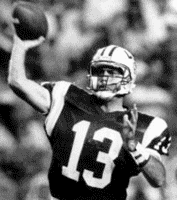
Tommy Hodson
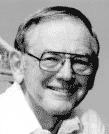
Bill Arnsparger
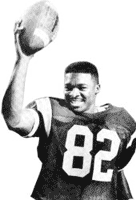
Wendell Davis
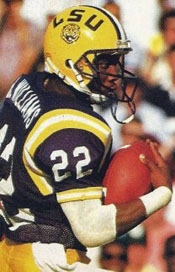
Harvey Williams
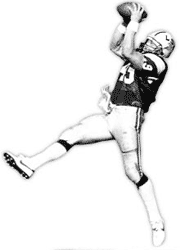
Brian Kinchen
Top of Page |
Tiger Firsts: NFL Draftee
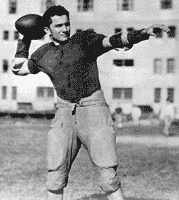
Abe Mickal
|
The nine NFL teams conducted the league's first draft on February 8, 1936. An LSU star was included in the selections during the nine rounds.
The Detroit Lions picked Tiger RB Abe Mickal in the sixth round. However, Abe, interested in medical school, didn't sign with Detroit and never played professional football.
Born in Syria, Abe came to the U.S. at age eight with his family, who settled in McComb MS. His father opposed Abe's playing football, preferring that his son learn to work rather than waste time in sports. But the boy's obvious ability eventually won his father over, and Abe earned 12 letters in football, basketball, baseball, and track. Notre Dame strongly recruited Abe, but Knute Rockne's death in an airplane accident caused Abe to choose LSU.
Mickal was one of Huey Long's favorites, so much so that Huey lobbied the legislature to make Abe a state senator. Worried that making a player a state senator might jeopardize his amateur standing since senators received $10 per day, AD Skipper "Red" Heard prevailed on Huey to remove Abe's name from the list. (Abe had not appeared for his swearing in anyway.) Coach Biff Jones also opposed the move, saying "I can't run a ball club like this. It's bad for morale." In response to this statement, Huey said, "Hell, Red, I'll make 'em all senators."
Mickal graduated from LSU Medical School in 1940, then served as a major in the army during World War II. After discharge, he enjoyed a long and distinguished career in Obstetrics and Gynecology in New Orleans. In 1959, he was appointed head of the LSU Medical School. Along the way, he stayed in touch with football by refereeing high school games.
Abe was inducted into the College Football Hall of Fame in 1967. He died in 2001 at age 89.
|
|
Interesting Story: It's a Miracle!
 Jarvis Green
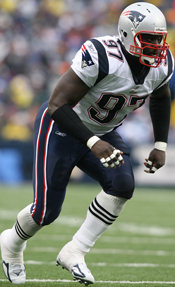
Jarvis Green, Patriots
|
Jarvis Green played DE for the New England Patriots from 2002-09 after four years at LSU. However, his college football career nearly ended before it started.
- Green injured his back in a minor auto accident in his hometown of Donaldsonville right before his freshman year. He suffered two fractured vertebrae and two bulging discs.
- After redshirting in 1997, Jarvis played in 1998 with his back still hurting. "I had to lay in the bed to do everything, including putting my shoes on."
- When the season ended, he rested his back and went to a chiropracter. He didn't do any Olympic lifting during the off-season. Still, when August workouts began, he still hurt.
- The night before the last preseason scrimmage, Jarvis, still in pain, prayed for a half hour before going to bed.
- Let Green tell what happened next. "I got up around 7:30 and didn't have to be up till nine. I was moving around and Kenderick [roommate Kenderick Allen] looked over and said, 'What the hell are you doing?'" Jarvis was moving his arms around, jumping, hitting the wall – with no pain whatsoever.
- In the scrimmage, Green had four sacks.
- "As the season went on, I was scared it might come up again. But it never did. But that really humbled me a lot. ... I was pain-free, and I thank God for that."
- To show how unpredictable life can be, a year and a half after the minor car accident, Green was in a more serious accident in Baton Rouge. The car he was driving was hit and spun around five or six times before going into a ditch. Yet he walked away from that one unscathed.
|
Dazzling Debut: Alvin Dark
Alvin Dark played one year of football at LSU but what a year it was! In 1942, Dark was a sophomore from Lake Charles High School. Many considered him too small at 160 lb for a running back, but he proved his critics wrong. Given a chance to play in the second game of the season against Texas A&M, Alvin dashed 25y for a touchdown.
Playing Ole Miss in Tiger Stadium in the fourth game of the season, Alvin dropped back to kick on fourth down from the Tiger 20.
- Alvin boomed a punt that sailed over the safety's head and out of bounds on the Rebel 10. 70y! However, the ball was brought back and a five-year offside penalty stepped off against Ole Miss!
- Coach Bernie Moore angrily removed Captain Walter Gorinski for accepting a penalty that nullified a 70y punt. But before Moore could chew out the miscreant, something amazing happened.
- Dark's foot slammed into the spheroid and sent it far over the safety's head again and out of bounds on the three! 73y!
- "You see, coach," Gorinski explained, "I was just showing my confidence in Alvin."
Adding to his memorable afternoon, Dark ripped off touchdown runs of 70 and 46y. He finished with 142y in only 11 attempts in the 21-7 victory.
Alvin passed for both touchdowns in the 16-6 triumph over Mississippi State to earn the "triple threat" acclamation. LSU finished 7-3, and Dark was selected to the 1942 All-SEC team. He also played basketball and baseball that year.
However, World War II ended Al's LSU career. He entered the Navy and was assigned to the V-12 program at Southwestern Louisiana Institute in Lafayette, where he played football and baseball. So many players joined Dark, including a number from Rice, T Billy Heard and G Jim Loflin of LSU, and E Art Porter of Tulane, that SLI could schedule only five games because coaches that previously played the Bulldogs (as they were known then) for an easy win wanted no part of them in 1943. SLI cruised to 4-0-1 season. Then they defeated Arkansas A&M, the team that had tied them, in the Oil Bowl in Houston on New Year's Day 24-7.
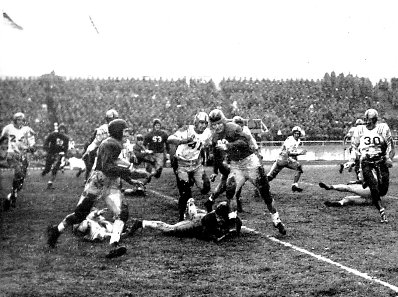
Al Dark runs for SLI in the Oil Bowl.
After the one-year V-12 program, Dark fulfilled his Navy obligation. He was taken in the 2nd round of the 1945 NFL Draft by the Philadelphia Eagles. However, he was also offered a $40,000 bonus by the Boston Braves. Coach Moore recalled that, when Dark talked to him about what he should do, "I told him to take it [the Braves' offer] before they changed their mind."
Alvin made National League Rookie of the Year in 1948 when the Braves made the World Series. He also played shortstop in the Fall Classic twice with the New York Giants, in 1951 and 1954, the latter a sweep of Cleveland. He managed the San Francisco Giants in the 1961 Series and the 1974 World Champion Oakland A's.
Despite playing only one year in Baton Rouge, Dark was inducted into the LSU Hall of Fame for baseball in 1981. |
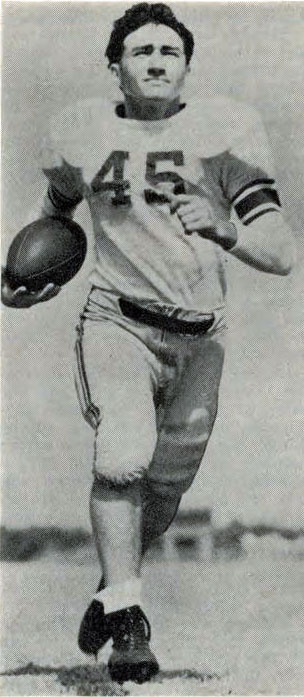 Alvin Dark, gridiron star
Alvin Dark, gridiron star
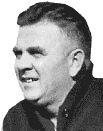
Bernie Moore

Alvin Dark, baseball star

Alvin Dark, manager
|
|
Dazzling Debut: Charlie McClendon
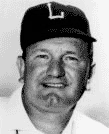
Charlie McClendon |
Charlie McClendon had big shoes to fill.
- Paul Dietzel had coached the Tigers to the '58 National Championship with his three platoon system in an era of limited substitution. Then came a 9-2 season in '59 and, after a reloading year in '60, 10-1-0 and an Orange Bowl victory and #4 AP rating in '61.
- When Dietzel bolted to West Point, D coordinator McClendon was the logical choice as his successor.
- However, personality-wise, Charlie Mac was a country bumpkin compared to suave Pepsodent Paul.
- McClendon took confidence from the return of all but seven of Dietzel's last three-deep squad including All-American HB/DB Jerry Stovall.
The largest opening night crowd in Tiger Stadium history, 68,618, turned out on Septembe 22, 1962, to watch Mac's debut as head man against Texas A&M.
- His defense did him proud, shutting out the Aggies 21-0.
- A&M had a new leader also, former Army standout Hank Foldberg, who replaced Jim Myers, only 12-24-4 after succeeding Bear Bryant, who had coached McClendon at Kentucky.
- QB Jimmy Field didn't pass much, but his 23y completion to E Jack Gates set up a 4y run by Go team HB Bo Campbell for the only score of the first half.
- Stovall roared 58y with the second half kickoff to set up his own 2y touchdown for a comfortable two-touchdown lead.
- FB Steve Ward tallied the final touchdown on a plunge.
- The visitors completed 10 of 19 passes but also threw 3 INTs, one by Field of the White team, which played both ways.
|
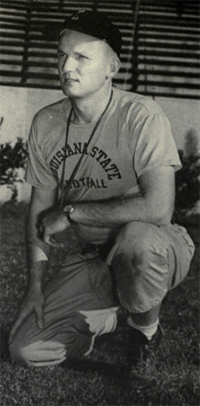 Paul Dietzel |
Mac's entire maiden season was dazzling. LSU went 8-1-1. The loss was to Ole Miss, 15-7, the only time all season the Tigers surrendered more than 7. In the Cotton Bowl, McClendon's D completed an outstanding season by shutting down Texas, 13-0.
Additional tidbit: The same night that McClendon debuted, Joe Namath took the field for the first time for Alabama.
Memorable Game: Tulane 1972 – "It was no more than that."
|
Top of Page |
85,372, the largest crowd ever to witness a college football game at night at that time, gathered in Tulane Stadium on December 2, 1972, to see if Tulane could finally end its winless streak against its archrival from up-river. The Green Wave had last defeated the Tigers in 1948 by a rousing 46-0. There had been two ties since (1950 and 1955) but no wins.
At halftime, the home team fans felt quite good.
- Bennie Ellender's Greenies led 3-0 on a FG by Lee Gibson.
- The TU D had totally bottled up All-American QB Bert Jones. They would sack him six times on the evening and hold him to only 5-of-13 passing for 63 yards.
In Q3, LSU received an apparent setback that actually helped them win the game. Jones had to leave the game with an injured shoulder. Enter scatback QB Paul Lyons.
- Lyons repeatedly escaped the Green Wave pressure to complete passes or run for positive yardage. In one case, he scampered 44y. He ended up with 70y on the ground, second only to Brad Davis's 77.
- Rusty Jackson's 29y FG tied the score in Q3. Then Juan Roca's 43-yarder put LSU on top in Q4.
- When Lyons led another drive that resulted in a 36y Jackson FG with only 1:07 left, LSU appeared to have iced the game. It was hard to believe that the TU O, which had been stuffed the entire second half, could actually score a touchdown.
- No one consulted sophomore QB Steve Foley on the matter. He suddenly got hot, completing three passes to reach the LSU 5 with only 0:06 left. Out of timeouts, Tulane quickly ran one more play, a play remembered ever since by fans of both schools.
- Foley hit Bill Huber with a pass at the 2, and he cut to his right to try to get to the EZ. However, DB Frank Racine made a game-saving tackle as the clock expired. Afterwards, Huber said, "It was no more than that," holding his hands about a foot apart to indicate how close he came to scoring.
I was sitting in the South end zone with my brother. We watched nervously as the play unfolded on the far end and cheered with relief when the clock ran out. It wasn't until the next morning that I learned from the newspaper that Huber had come so close to scoring.
Tulane S David Lee agreed that Lyons was the difference in the game. "No doubt we'd rather have had Jones in there. He doesn't like to run, and we knew it."
It was the first time since a 0-0 tie in 1928 that neither team scored a touchdown in the series.
The following year, to balance its home/road schedule, LSU switched the Tulane game back to New Orleans. McClendon said the week of that game that the ball wouldn't be placed on the one yard to start play. However, TU did finally break the streak with a 14-0 victory that I also attended.
|
Memorable Game: Tennessee 2000 – Myth Indeed!
LSU was at a crossroads after four games of its first season under Nick Saban.
- The Tigers won their first two games, 58-0 over I-AA Western Carolina and 28-13 over Houston.
- LSU lost at Auburn 34-17. The bright spot was the emergence of Josh Reed as a go-to receiver. Transferred from RB at the suggestion of QB Josh Booty, Reed caught eight passes for 167 with touchdowns of 74 and 45.
- Hosting Alabama-Birmingham, LSU committed six turnovers, dropped six passes, and was penalized 13 times for 113.
- Still, the Tigers were tied at 10-10 with 33 seconds left. Having the ball on their own 29, LSU needed only to run out the clock to go to OT.
- However, Booty audibled to a pass that was not in the playbook. UAB intercepted and kicked the winning FG as time expired for an improbable 13-10 win.
Desperately needing to bounce back, the Tigers would have to do so against the #11 Tennessee Vols. Gary Lundy of the Knoxville News-Sentinel wrote the week of the game that Tiger Stadium's reputation as a difficult place for visiting teams was a myth. 700 Tiger fans sent Lundy angry e-mails. Fortunately, Saban's squad gave the definitive rebuttal.
- With the East upper deck in place for the 2000 season, a record crowd of 91,682 made the stadium shake at times with their noise.
- Saban decided to start Rohan Davey behind C but didn't tell him until right before kickoff.
- Playing on an injured left knee and right ankle, Davey completed 23 of 35 for 318 and 4 touchdown, including two to Reed.
- The Tigers roared to a 24-6 halftime lead.
- However, the Vols fought back to tie the game against an obviously tiring LSU D 31-31 on a 16y pass with 1:30 left.
- In OT, LSU got the ball first and scored on the first play - a 25y pass from Davey to TE Robert Royal down the middle between two defenders.
- Tennessee moved to fourth and goal on the 4. But Damien James broke up a pass in the EZ, and fans flooded the field to tear down the goalposts.
The game provided Saban with his first signature win in Baton Rouge. Later in the season, LSU defeated Mississippi State in OT in similar fashion.
|

Nick Saban
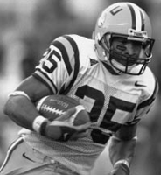
Josh Reed
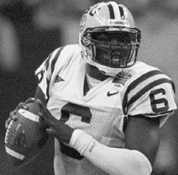
Rohan Davey
|
Interesting Story: Dynamic Duo - I
LSU fired Coach Gaynell "Gus" Tinsley following the 1954 season. Tinsley, one of the greatest players ever to wear purple and gold, had compiled a 35-33-6 record in six seasons. Also, AD "Red" Heard had retired. So the Board of Supervisors went to work to fill both positions early in 1955.
The list of official and unofficial applicants for the coaching position was quite long.
- Head coaches Jim Tatum of North Carolina, Red Sanders of UCLA, and Bear Bryant of Texas A&M had expressed interest to certain board members or persons who would relay their interest to the board.
- Another head coach who was more than a little interested was Ara Parseghian of Miami (OH). He even had his AD intervene for him with LSU President Troy Middleton who asked the logical question: If your guy is so good, why are you recommending him to us? The AD answered that they knew they weren't going to be able to keep Ara and wanted him to get the job at a "major" school.
- To narrow the list of candidates, the screening committee decided not to consider: (a) a head coach under contract, (b) a head coach who had been fired, or (c) an SEC assistant, including LSU assistants. This last provision ruled out Ray Graves and Frank Broyles at Georgia Tech, both of whom would go on to head coaching success at Florida and Arkansas, respectively.
- This left six to be interviewed: Ben Martin, Navy assistant (who would later coach Air Force); Stan Galloway, assistant at Southeastern Louisiana (and later the head coach there); Paul Dietzel, assistant at Army who had also served two years under Bryant at Kentucky; Ed McKeever, former LSU assistant now in private business in Baton Rouge; Chuck Purvis, assistant at Illinois; and Perry Moss, assistant at Miami (FL).
After all six were interviewed, the committee was most impressed with Dietzel, who had been recommended by former LSU coach Biff Jones, who had coached at West Point and was still close to the program there. Only 29, Dietzel would bring youthful enthusiasm to Tiger football. When told during the interview that he must retain all of Tinsley's assistants, Dietzel took out a stack of note cards he had prepared on the assistants. It didn't hurt Paul's cause when the President of Kentucky called General Middleton to recommend the former Wildcat assistant, who had almost gotten the UK job the year before when it appeared that Blanton Collier was going to turn it down.
Screening committee chair Ike Carriere, an LSU star in the 1920s, spoke for 50 minutes in recommending Dietzel to the entire Board of Supervisors. When Paul was hired on February 16, 1955, he became the youngest member of his staff.
The committee now turned its attention to filling the AD position.
Reference: The Fighting Tigers II: LSU Football, 1893-1980, Peter Finney |

Paul Dietzel
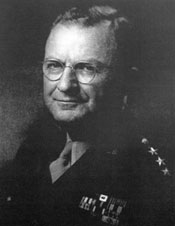
LSU President, General Troy Middleton
Top of Page |
Interesting Story: Dynamic Duo - II
Having hired Paul Dietzel as the new LSU coach for 1955, the screening committee began its search for a new AD.
The list of interested parties was much shorter than it had been for the coaching job. In fact, the committee focused on only one man - Jim Corbett, who had worked as LSU's sports publicity director from 1945-8 and 1950-3. Most recently, he had worked as the coordinator of NBC's college football telecasts.
Corbett hailed from Arlington MA. How did he end up in Baton Rouge?
- Jim had shown initiative and creativity at a very early age. He had talked his way into a scholarship at Austin-Cate, a private school in Maine, offering to recruit three football players for the school in return for free tuition.
- Through a person in his area who was a talent scout for football teams, Jim was invited to try out for the football team at Southeastern Louisiana College in 1940. He hitch-hiked south, stopping along the way to work at various jobs to pay for the trip.
- Jim made the freshman team at SLC, but a leg injury ended his career before his sophomore year. Faced with the loss of his scholarship and the end of his college education, he convinced school officials the athletic department needed a publicity director. The school agreed to the position on a trial basis in return for Jim retaining his scholarship. He passed the test, keeping the job until he graduated in 1944.
- Jim went to work for the Associated Press (AP), first in New Orleans, then in BR. When LSU had an opening for a sports publicity director in August 1945, he applied and got the job.
It is no exaggeration to say that the hiring of 35-year-old Jim Corbett and 29-year-old Paul Dietzel laid the foundation for the building of an athletic program that became one of the best in the nation. In Dietzel's fourth season, LSU won the national championship and began filling the 67,000 seats in the enlarged stadium.
|

Jim Corbett

Tiger Stadium after expansion in 1955
|
|
CONTENTS
Tiger Firsts: Victory, Home Victory, Winning Season
Interesting Story: You Can't Keep a Good Man Down
Tiger Firsts: NFL Draftee
Interesting Story: It's a Miracle!
Dazzling Debut: Alvin Dark
Dazzling Debut: Charlie McClendon
Memorable Game: Tulane 1972
Memorable Game: Tennessee 2000
Dynamic Duo - I
Dynamic Duo - II
Tiger Den Archives – I
Tiger Den Archives – II
Tiger Den Archives – III
Tiger Den Archives – V
Tiger Den Archives – VI
Tiger Den Archives – VII
Tiger Den Archives – VIII
Tiger Den Archives – IX
Tiger Den Archives – X
Tiger Den Archives – XI
Tiger Den Archives - XII
Football Magazine
Golden Rankings Home
Top of Page
|









